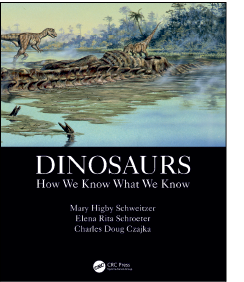


Dinosaurs and scientific inquiry
Mary Higby Schweitzer, Elena Rita Schroeter, Charles Doug Czajka 2021. Dinosaurs: How We Know What We Know. 547 pp. CRC Press, Taylor and Francis Group. ISBN: 978-0-367-56381-3. Price USD 79.96 (paperback); eBook USD 79.96.
The study of dinosaurs has now been in its “golden age” for as long as many current researchers have been active in the field, with no end in sight. In the quarter century since the first publication of feathered non-bird dinosaurs from China—to name one event marking an explosion of interest and innovation—paleontologists and our colleagues from other disciplines have employed creative applications from biochemistry, materials science, histology, biomechanics, and comparative anatomy to infer more about the biology of past life than once thought possible. Facts and speculations about these majestic reptiles are more plentiful and easier to access online than ever. With so much information of varying quality inundating them, how then can an interested layperson, avocational paleontologist, or student begin to make sense of it all?
A fresh, convincing approach is offered by Mary Schweitzer and colleagues in their new 20-chapter textbook Dinosaurs: How We Know What We Know. M. Schweitzer is a globally recognized innovator in molecular paleontology. She collaborated with E. Schroeter, a paleoproteomics expert, and C. Czajka, a geoscience education authority, to produce a book that is more than equal to the sum of their professional experiences. The complementary research strengths of the authors and their facility with teaching both the biological and geological sides of paleontology are evident in the organization and content of the book.
This book is designed to work equally well as a textbook for the many introductory-level dinosaur courses now popular among science and non-science majors alike, and for the advanced elective courses on dinosaurs offered at a few universities with paleontology concentrations. Its content reflects this dual approach. The first six chapters offer a solid grounding in core concepts of scientific inference and hypothesis testing, geology, evolution, phylogenetic systematics, the history of life, and comparative anatomy. These are especially useful for students new to scientific ways of thinking, and the review of foundational bioscience and geoscience concepts is a concentrated version of that offered by introductory organismal biology and geology courses.
The middle four chapters define Dinosauria, introduce all of the major clades of saurischian and ornithischian dinosaurs, and conclude with an overview of Mesozoic animals that lived alongside dinosaurs (e.g., marine reptiles, pterosaurs, mammals). These chapters successfully walk the line between providing enough detail to be useful to advanced undergraduates/graduate students and not overwhelming beginners with a deluge of minutia.
The final ten chapters of the book tackle exciting and oft-controversial topics in dinosaur and vertebrate paleontology broadly, including fossilization processes, paleoecology, functional morphology, life appearance, diet, behavior, reproduction, physiology, the origin of birds, and mass extinctions. The treatments here are generally up-to-date and fair to all sides where differing methodological approaches and interpretations of the primary data are concerned. Taken as a whole, the three sections admirably provide equivalent depth across a vast range of topics while remaining sufficiently modular to accommodate differing needs of individual instructors, not an easy feat to accomplish.
The writing style is lively and directly addresses the reader with a casual, inviting tone. New key words are presented in italics, though a glossary of these terms is not included. Each subsection begins with specific aims for students to accomplish upon reading that section. All chapters conclude with “What We Don’t Know” and “Questions to Consider” sections, sure to be useful as launching points for assignments, class discussions, or semester-long research projects. Most chapters also acknowledge the external expert reviewer(s) of that chapter and contain a list of references for students or instructors interested in digging deeper.
The abundant full-color figures are derived from various sources, including Kaitlyn Tiffany (who photographed many specimens and museum exhibits specifically for the book), the primary literature, and Wikimedia Commons. The photographs are generally of high quality and well chosen for the concepts and species they are intended to portray. I especially appreciated the standardized approach in the taxonomic chapters of using photographs of real fossil bones or casts thereof against black backgrounds, often with key anatomical features clearly labeled. This is an important stylistic choice that supports the authors in their desire to ground students in returning to the original specimens as the primary source of raw data for hypothesis testing. The sequential cladograms in the taxonomic chapters are simple, clear roadmaps to guide students through the intricacies of dinosaur evolution and classification.
In sum, this book is an up-to-the-minute, thorough, and intellectually dynamic contribution to dinosaur science and post-secondary science education. It sets a new benchmark for books of its kind with a format that aims to equip students with the critical thinking tools and creativity necessary to formulate and test hypotheses, both in careers in the historical sciences and as informed members of society. The goals of both science pedagogy and the paleontological research community will be well-served if this becomes a standard text used to enlighten and inspire students.
Daniel E. Barta [daniel.barta@okstate.edu], Department of Anatomy and Cell Biology, Oklahoma State University College of Osteopathic Medicine at the Cherokee Nation, Tahlequah, Oklahoma, USA.
Acta Palaeontol. Pol. 66 (2): 436, 2021
http://doi.org/10.4202/app.00898.2021